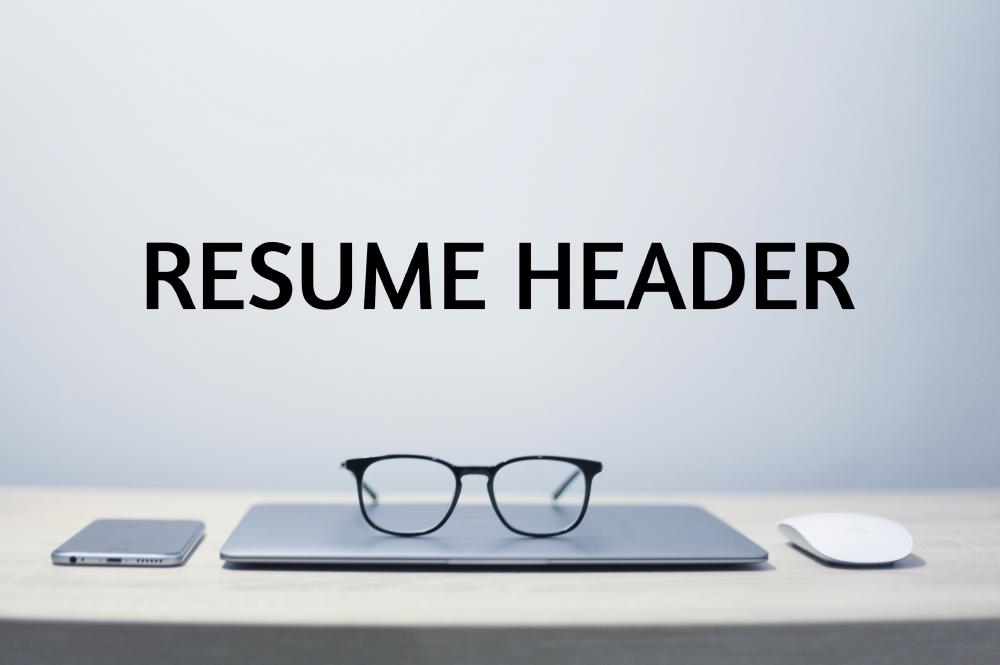



A resume header is only one insignificant element that starts off the main self-marketing and branding tool for most job seekers. Even though many applicants don’t believe that a header plays any role in the overall evaluation of the document, it can actually disqualify one from the competition. If a job seeker messed up a resume header, most likely no employer would want to keep reading.
Imagine you are running a soccer try-out for your professional team and there comes a player who can’t even hit the ball. Would you consider taking such a “player” on your team? Unless your objective is to lose all games in the season, you probably won’t. The same principle applies to how hiring authorities evaluate candidates. Messing up a resume header is failing at the very basic level; thus, job seekers need to make sure their resume headers don’t contain silly mistakes that can cost them an opportunity. But what can possibly go wrong with a header on a resume? Before we proceed to the most common mistakes of writing a resume header though, let’s start from the most basic question – what is a header on a resume?
What is a header on a resume?
A resume header is the first section that employers stumble upon when reviewing applications. It usually features the name and contact information. However, it is not limited to name and contacts; this section can also include portfolio links, LinkedIn link, and sometimes even a brief title.
It is important to distinguish between a resume headline and resume headline though as these are not the same terms. The latter refers exclusively to the title and/or a brief phrase highlighting one’s professional value. Here is the difference.

What to include in a resume header?
Almost all resumes have headers. The difference is what information they feature. That said, many job seekers wonder what they should add to a header on a resume… Or, in other words, what kind of information a good header should include?
Here are the must-haves:
Name. This one is obvious. A resume without a name will look very weird and including a name is absolutely a must. Choose a name based on how you’d like people to refer to you in the workplace and who you identify with as a professional.
Physical address. Listing your physical address shows employers you are not hiding anything and helps them know your commute time. Besides, sometimes, companies want to hire people from a specific area.
Email address. Usually, this is the primary means of contact. Leaving your email off can be a deadly mistake and will certainly be a reason to raise eyebrows for hiring managers.
Contact phone number. Another way how employers can contact you to invite for an interview. Sometimes, HRs like to run a brief phone interview before inviting candidates for a regular office interview.
Additionally, you may want to add:
LinkedIn Profile link. Many employers use this social network to source candidates. If you haven’t created a LinkedIn profile, we strongly recommend you do. It will keep you open to more opportunities.
Portfolio link. This is a great way to showcase your professional skills. If you are a designer, software developer, photographer, creating a portfolio online is a must if you take job search seriously.
Personal website link. This one is very similar to a portfolio as it usually features the works of a candidate. However, a website can provide more details so if you have the chance to create your own website – go ahead.
Headline (Title). Some career experts include a resume title in a header while some prefer to keep it separate. There is no right or wrong approaches here. At Prime-Resume, we view the title as separate components that requires special attention from the candidates.
What can possibly go wrong with a header on a resume?
How in the world someone can mess up a resume header? Taking less than 10% of the space, it seems that it is really difficult to do something wrong with this particular section. Well, guess what… many job seekers still do it! Starting with the basics, instead of putting their real name candidates think it is funny to have a nickname instead. Sometimes, really weird nicknames are sometimes used that should be mentioned in the company of close friends only. An unprofessional email address can also become a huge turn-off (i.e. lovebird48303@hotmail.com, luckyandfluffyMay89@yahoo.com, stupidtractor@ymail.net, etc.). Leaving your physical address off will unlikely be a big red flag for all employers reviewing your resume but it can certainly raise eyebrows of some. Lastly, it is not a good idea to include your LinkedIn profile link if your page is blank or looks like a mess.
Resume header format
Because a resume header always comes first on the document, it is important to format it correctly. If you do, it will be convenient for the recruiters to see your name at the very beginning.
When it comes to formatting, there is no only one way to do it. For example, you can select it as the right margin, put it at the center, or set it as the left margin. The most important thing about resume headers is to make sure your name stands out so it is a good idea to make the text size bigger for your name compared to the rest of the information. In other words, your name should be the biggest think on your resume. Make sure you keep the same name across all your social networks and websites.
Either under your name, next to it, or on the opposite side of the page you should include the rest of the information (physical address, email address, contact phone number, LinkedIn ID, portfolio link, you’re your website). Depending on how many of these components you have, you may either list this information in one line or split it into two.
Resume header examples
Resume Header Example #1

Resume Header Example #2

Resume Header Example #3

Resume Header Example #4

Resume Header Example #5

Resume header questions and answers
There are some questions about resume headers that seem to bother job seekers. For example, “What’s the best resume design?”, “Should resume header fonts be different from the rest of the content?” “Should a cover letter have an identical header?”, “Should I duplicate header on a second page?”, etc. We have collected the most popular questions and decided to briefly answer them to help job seekers develop a professional resume. Every professionally written resume starts with a header after all.
What’s the best resume header design?
Resume header design doesn’t play a great role unless it is terribly done. The rule of a thumb is to keep the header design consistent with the formatting of the document. There is no need to add colors or additional graphic elements. Just keep it in line with your document's formatting. Remember that a resume header is a part of the bigger picture. And while it is a good idea to highlight this section, there is no need to go to the extremes. The more consistent your resume looks, the more professional it is perceived by those reading it and making hiring decisions. So unless you seek the job of a designer, it is better to for a traditional black-and-white design.
You can use a different font for your resume header – this will ensure your name and contact information will stand out. If you have two or more resume fonts within your main body, then don’t use a new one. The rule of a thumb to use not more than two different fonts.
How to create a professional resume header?
Apart from the design, a good resume header looks professional when it features your name (not an inappropriate nickname), professional email address, your real physical address, and links to social network accounts that look professional. If you manage to avoid making mistakes when writing these, most likely you will get a decent looking resume header then.
Should I use a 2-page resume header?
Not all resumes are one-page documents (and they do not need to be). So the question of whether you should duplicate your header on a second page (and following pages) is legitimate. We believe it is totally fine to have a header on the second page of a resume. However, it all depends on the available space you have. For example, if duplicating your header on a second page will mean that your content will spill over the third page then you may want to either remove a 2-page resume header at all or have it cut (displaying your name only for example). To save valuable resume space, we recommend placing this section in the document’s header if you are using MS Word.

Should cover letter have the same header as a resume?
A cover letter is an accompanying document. It is meant to complement your resume and address potential red flags that could be found there. That said, it is better if a cover letter has the same header as a resume. Marching your cover letter to resume in such small ways will send a message to employers regarding your consistency and attention to detail. This gives one more reason to consider you as a job candidate more seriously.







